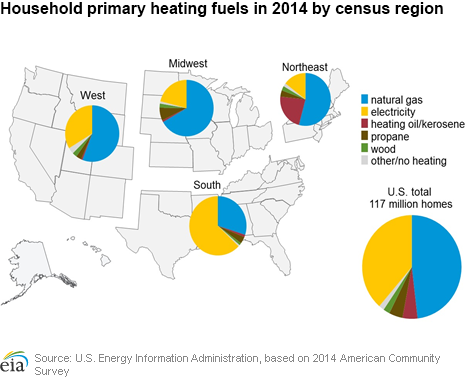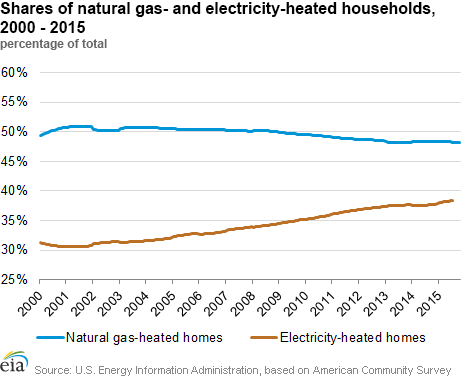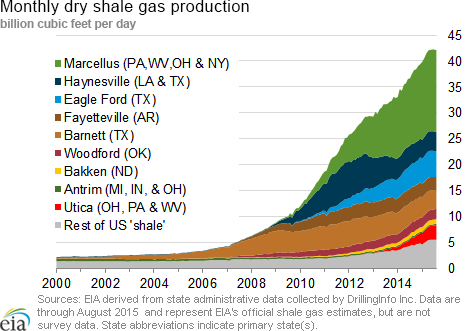In the News:
Natural gas heating bills expected to be lower this winter
Nearly half of households in the United States use natural gas as their primary heating fuel, and they can expect a 10% decrease, on average, in their winter natural gas bills this year compared with last year. The decrease is the result of both lower year-over-year forecasted residential prices and a warmer winter compared to last year. The average natural gas consuming household can expect a total winter natural gas bill of $578 this winter, $64 less than last winter's average, according to EIA's Short-Term Energy and Winter Fuels Outlook. Markets are currently characterized by relatively low prices and strong supply.
Heading into the winter, EIA forecasts supplies will be abundant and working inventories of natural gas in storage will be at a record high of 3,956 billion cubic feet (Bcf) on October 31. If weekly injections remain strong in the coming weeks, it is possible that working inventories could surpass 4,000 Bcf. This would exceed the previous record of 3,929 Bcf set at the end of October 2012. EIA projects inventories next March will end this winter at 1,892 Bcf, which would represent a drawdown of 2,064 Bcf. This represents high March levels and a lower winter drawdown than in the previous five years (2011 — 15) —the five-year average end-of-March inventory level is 1,622 Bcf, and the average winter drawdown over these years is 2,176 Bcf.
In addition to forecasts for record storage levels, EIA expects production growth will continue this winter. While production growth has slowed in recent months, EIA expects production will remain well above year-ago levels. This month's STEO projects total dry production will average 75.2 Bcf/d between October and March, about 2.5% greater than the 2014-15 winter.
The projections for heating bills are based on forecasts of residential natural gas consumption and prices. While EIA expects residential prices will remain lower than in previous years, they are not directly correlated with changes in Henry Hub spot prices. EIA projects residential prices overall in the United States to average $9.51 per thousand cubic feet (Mcf) this winter, which is 40¢ lower than the per-unit price last winter. EIA forecast that consumers in all four census regions (West, Northeast, South, and Midwest) will see lower natural gas bills this winter.
The National Oceanic and Atmospheric Administration (NOAA) projects this winter will be substantially warmer than last year in the Midwest, Northeast, and South. In the West, which was warmer than average last year, NOAA expects cooler temperatures.
In 2008, homes heated with natural gas made up slightly more than half of total U.S. homes. Over the past several years, natural gas-heated homes have declined as a share of the total, while homes using electricity as their primary source of heat have increased. This pattern is likely caused by increases in population in southern states where electricity is the predominant source of heat.
Overview:
(For the Week Ending Wednesday, October 7, 2015)
- Natural gas prices declined slightly in most market locations over the report week (Wednesday, September 30, to Wednesday, October 7), with the exception of the Northeast. The Henry Hub spot price began the week at $2.47 per million British thermal units (MMBtu) last Wednesday then closed the week down by 1¢ at $2.46/MMBtu yesterday.
- At the New York Mercantile Exchange (Nymex), the November near-month contract decreased from $2.524/MMBtu last Wednesday to $2.474/MMBtu yesterday.
- Working natural gas in storage increased by 95 Bcf, rising to 3,633 Bcf as of Friday, October 2. The net injection into storage resulted in storage levels 14% above a year ago and 4% above the five-year average for this week.
- The total rig count declined by 29 units from the previous week, with 809 units in service as of October 2, according to data released by Baker Hughes Inc. This was 1,113 units below the number of rigs during the same week last year. The oil rig count decreased by 26 units to 614, while the gas rig count declined by two units to 195. Gas rigs this week are down 41% over the same week last year, whereas oil rigs are down 61%.
- The natural gas plant liquids composite price at Mont Belvieu increased by 0.6% to $5.06/MMBtu for the week ending October 2. Ethane, butane, and isobutane prices increased by 2.1%, 1.5%, and 1.9%, respectively, while natural gasoline and propane prices each decreased by 0.3%.
Prices/Demand/Supply:
Henry Hub price reaches lowest level since July 2012. The Henry Hub spot price began the report week last Wednesday at $2.47/MMBtu, then dropped 21¢ by Friday to $2.26/MMBtu, the lowest Henry Hub spot price since July 2012. The price then rose to close at $2.46/MMBtu yesterday. Prices in most markets, except the Northeast, followed a similar pattern, ending down for the week, after reaching weekly lows on Friday. Chicago Citygate spot prices started at $2.56/MMBtu last Wednesday and closed yesterday at $2.46/MMBtu. At PG&E Citygate, serving Northern California, prices started the report week at $2.99/MMBtu and closed yesterday at $2.96/MMBtu.
Northeast prices fluctuate. At the Algonquin Citygate, which serves Boston-area consumers, prices began the week at $1.95/MMBtu before falling to $1.47/MMBtu on Friday, but then rose to close the report week at $2.77/MMBtu. Similarly, spot prices at Tennessee Zone 6, Line 200 (covering parts of New England) began the week at $2.08 on Wednesday, dipped to $1.31/MMBtu on Friday, and then rose to $2.63/MMBtu yesterday. At Transcontinental Pipeline's Zone 6 delivery point into New York City, prices began the week at $2.44/MMBtu, dropped to a weekly low at $1.56/MMBtu on Friday, and rose to $2.45/MMBtu yesterday to end the week. Northeast prices were likely influenced by an operational flow order (OFO) placed by Algonquin on Tuesday, that placed some delivery constraints on the Algonquin system.
Marcellus-area prices end the week below $1. Marcellus-area prices were mixed this week, but remained low. At Tennessee Pipeline's Zone 4 Marcellus trading zone, prices fell from 83¢/MMBtu last Wednesday to 78¢/MMBtu yesterday. On the Transco Leidy Line, prices began the week at 81¢/MMBtu, fluctuated through the week with a low of 66¢ and a high of 99¢, then settled to close at 84¢/MMBtu yesterday. At Dominion South, which serves customers in portions of Pennsylvania, Ohio, Maryland, West Virginia, and Virginia, prices began the report week at $1.22/MMBtu, fluctuated through the week to close yesterday at 98¢/MMBtu.
Transcontinental Pipeline began maintenance at its Station 515 in eastern Pennsylvania on October 1. The maintenance outage is scheduled to continue through October 22, and is part of its Leidy Southeast Project expansion. This may limit supplies going to the Northeast from the Marcellus region.
Nymex prices drop. The November prompt-month spot contract ended the week at $2.474/MMBtu, down from $2.524 at the start of the report week. The 12-month strip (the average of the 12 contracts between November 2015 and October 2016) dropped slightly from $2.746/MMBtu last Wednesday to $2.729/MMBtu yesterday.
Supply is down. Dry production fell 0.5% for the report week, but was 3.7% above the same week last year, according to Bentek Energy data. Canadian imports increased by 5% over last week, though they were 5.8% below this same week last year. Regionally, the Northeast continued as a net-exporter to Canada during this report period. U.S. imports from Canada to the Midwest decreased by 3.6% for the week, while they increased by 5.6% in the West. LNG sendout was down by 34.1%, remaining at minimal levels.
Consumption rose for the week. Total consumption rose by 1.9% week over week and was 0.4% above consumption for the same week last year. Consumption of natural gas for power generation fell 10.8% in response to generally mild temperatures, though residential and commercial consumption rose 28%, when compared to last week. Consumption in the industrial sector rose 1.8%. U.S. exports to Mexico decreased by 5.8% when compared to the previous week; however exports to Mexico were up nearly 50% over the same period in 2014.
Hurricane Joaquin heads to the east, but heavy rain and wind cause power disruption in the Southeast. While Hurricane Joaquin, rated as high as a category 4 hurricane, shifted track away from the United States, heavy rains and strong winds from an inland storm slowly moved across parts of the Southeast over the weekend. With wind gusts of up to 50 miles per hour reported, 86,055 customers in Georgia, North Carolina, South Carolina, and Virginia lost power, potentially reducing natural gas consumption for the region. In South Carolina, in particular, localized flooding slowed power restoration efforts.
Storage
Net storage injection is larger than the five-year average. The net injection reported for the week ending October 2 was 95 Bcf, down from 98 Bcf the previous week. This injection compares with the five-year average increase of 92 Bcf for the week and last year's increase of 106 Bcf. Working gas inventories for the report week totaled 3,633 Bcf, 443 Bcf (14%) higher than last year at this time and 155 Bcf (4%) higher than the five-year (2010-14) average.
Storage injections are somewhat smaller than market expectations. Market expectations, on average, called for a build of 99 Bcf for this week. When the EIA storage report was released at 10:30 a.m. on October 8, the November Nymex price rose about 2¢, and averaged about 1¢ above the prerelease price in the following hour, at $2.51/MMBtu.
From April 3 (the beginning of the injection season) through October 2, net storage injections totaled 2,172 Bcf, or 185 Bcf lower than the 2,357 Bcf injected during the same 27 weeks in 2014. During these weeks for the years 2010-14, net injections into storage averaged 1,827 Bcf. The estimated average unit value of the natural gas put into storage from April 3 to October 2 this year is $2.73/MMBtu, 36% lower than the average value of $4.27/MMBtu for the same 27 weeks last year. The highest winter-month Nymex price (for the January 2016 contract) in trading for the week ending October 2 averaged $2.80/MMBtu. This price is 33¢/MMBtu more than the November Nymex contract price. A year ago, the difference was 23¢/MMBtu.
Working gas stocks for this report week passed the 2014 peak of 3,611 Bcf, which was reached the week ending November 7. EIA forecasts that working gas stocks will also surpass the previous record-high weekly level of 3,929 posted for November 2, 2012. The September EIA Short-Term Energy Outlook forecasts working gas levels totaling 3,956 Bcf by October 31. Although working gas levels are about 83 Bcf below the level posted at a similar point in 2012, net injections into storage often continue well into November. If the rate of net injections follows the 5-year (2010-14) average for the next five weeks, working gas levels will total 3,960 Bcf by November 6.
Temperatures during the storage report week are warmer than normal. Temperatures in the Lower 48 states averaged 68° for the storage report week, 5° warmer than the 30-year normal temperature and 2° warmer than the average temperature during the same week last year. There were 38 population-weighted cooling degree days (CDD) this report week, 10 CDD more than the five-year average and 11 CDD more than this week last year. There were also 17 population-weighted heating degree days (HDD) during this report week, 3 HDD fewer than the five-year average and equal to the average HDD during the same period last year.
See also:
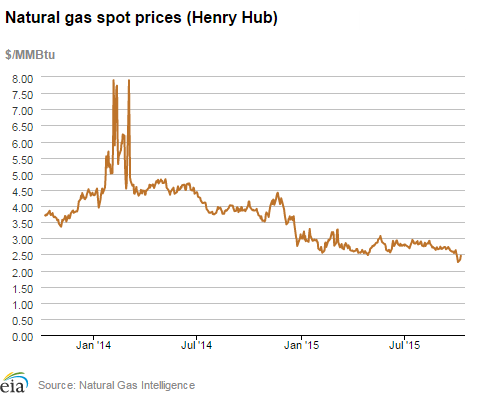
| Spot Prices ($/MMBtu) | Thu, 01-Oct |
Fri, 02-Oct |
Mon, 05-Oct |
Tue, 06-Oct |
Wed, 07-Oct |
|---|---|---|---|---|---|
| Henry Hub |
2.37 |
2.26 |
2.32 |
2.35 |
2.46 |
| New York |
2.13 |
1.56 |
2.28 |
2.40 |
2.45 |
| Chicago |
2.46 |
2.28 |
2.35 |
2.37 |
2.46 |
| Cal. Comp. Avg,* |
2.59 |
2.44 |
2.55 |
2.55 |
2.60 |
| Futures ($/MMBtu) | |||||
| November contract |
2.433 |
2.451 |
2.450 |
2.470 |
2.474 |
| December contract |
2.631 |
2.664 |
2.676 |
2.673 |
2.676 |
| *Avg. of NGI's reported prices for: Malin, PG&E citygate, and Southern California Border Avg. | |||||
| Source: NGI's Daily Gas Price Index | |||||
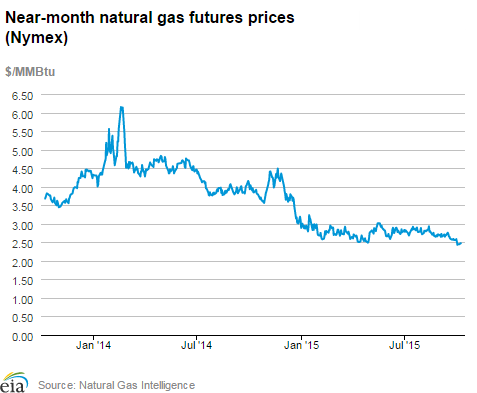
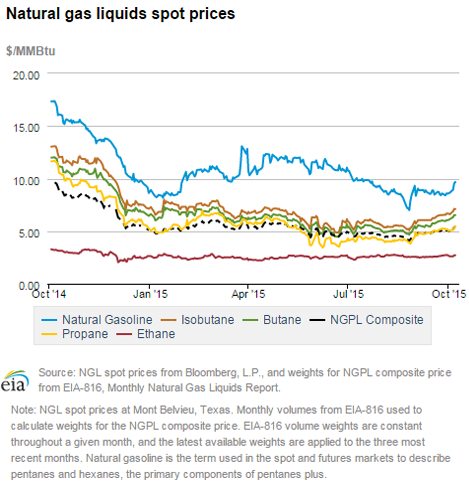
| U.S. natural gas supply - Gas Week: (9/30/15 - 10/7/15) | ||
|---|---|---|
Percent change for week compared with: |
||
last year |
last week |
|
| Gross production | 3.72%
|
-0.55%
|
| Dry production | 3.69%
|
-0.55%
|
| Canadian imports | -5.75%
|
5.04%
|
| West (net) | 5.25%
|
5.65%
|
| Midwest (net) | -22.47%
|
-3.64%
|
| Northeast (net) | -58.24%
|
-59.08%
|
| LNG imports | N/A |
N/A |
| Total supply | 3.00%
|
-0.24%
|
| Source: BENTEK Energy LLC | ||
| U.S. consumption - Gas Week: (9/30/15 - 10/7/15) | ||
|---|---|---|
Percent change for week compared with: |
||
last year |
last week |
|
| U.S. consumption | 0.4%
|
1.9%
|
| Power | 2.9%
|
-10.8%
|
| Industrial | -2.1%
|
1.8%
|
| Residential/commercial | -0.2%
|
28.0%
|
| Total demand | 1.9%
|
1.5%
|
| Source: BENTEK Energy LLC | ||
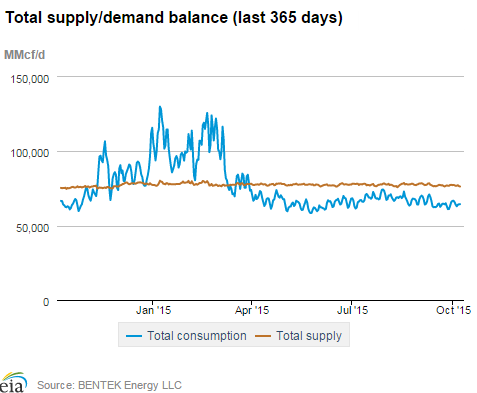
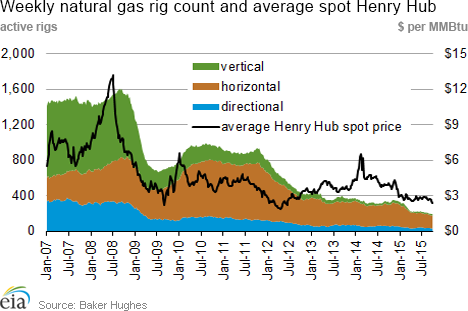
| Rigs | |||
|---|---|---|---|
Fri, October 02, 2015 |
Change from |
||
last week |
last year |
||
| Oil rigs | 614 |
-4.06% |
-61.41% |
| Natural gas rigs | 195 |
-1.02% |
-40.91% |
| Miscellaneous | 0 |
-100.00% |
-100.00% |
| Rig numbers by type | |||
|---|---|---|---|
Fri, October 02, 2015 |
Change from |
||
last week |
last year |
||
| Vertical | 117 |
-4.88% |
-68.55% |
| Horizontal | 609 |
-3.18% |
-54.59% |
| Directional | 83 |
-3.49% |
-60.29% |
| Source: Baker Hughes Inc. | |||
| Working gas in underground storage | ||||
|---|---|---|---|---|
Stocks billion cubic feet (bcf) |
||||
| Region | 2015-10-02 |
2015-09-25 |
change |
|
| East | 1,861 |
1,804 |
57 |
|
| West | 510 |
502 |
8 |
|
| Producing | 1,262 |
1,232 |
30 |
|
| Total | 3,633 |
3,538 |
95 |
|
| Source: U.S. Energy Information Administration | ||||
| Working gas in underground storage | |||||
|---|---|---|---|---|---|
Historical comparisons |
|||||
Year ago (10/2/14) |
5-year average (2010-2014) |
||||
| Region | Stocks (Bcf) |
% change |
Stocks (Bcf) |
% change |
|
| East | 1,767 |
5.3 |
1,883 |
-1.2 |
|
| West | 462 |
10.4 |
496 |
2.8 |
|
| Producing | 960 |
31.5 |
1,099 |
14.8 |
|
| Total | 3,190 |
13.9 |
3,478 |
4.5 |
|
| Source: U.S. Energy Information Administration | |||||
| Temperature -- heating & cooling degree days (week ending Oct 01) | ||||||||
|---|---|---|---|---|---|---|---|---|
HDD deviation from: |
CDD deviation from: |
|||||||
| Region | HDD Current |
normal |
last year |
CDD Current |
normal |
last year |
||
| New England | 41
|
-18
|
10
|
7
|
6
|
4
|
||
| Middle Atlantic | 21
|
-26
|
5
|
9
|
4
|
5
|
||
| E N Central | 28
|
-23
|
-3
|
10
|
5
|
7
|
||
| W N Central | 30
|
-21
|
10
|
19
|
10
|
-7
|
||
| South Atlantic | 7
|
-13
|
1
|
59
|
14
|
8
|
||
| E S Central | 6
|
-13
|
2
|
41
|
11
|
-3
|
||
| W S Central | 1
|
-4
|
0
|
77
|
20
|
10
|
||
| Mountain | 11
|
-44
|
-17
|
54
|
28
|
25
|
||
| Pacific | 7
|
-10
|
-1
|
48
|
29
|
36
|
||
| United States | 17
|
-19
|
0
|
38
|
14
|
11
|
||
|
Note: HDD = heating degree-day; CDD = cooling degree-day Source: National Oceanic and Atmospheric Administration | ||||||||
Average temperature (°F)
7-Day Mean ending Oct 01, 2015
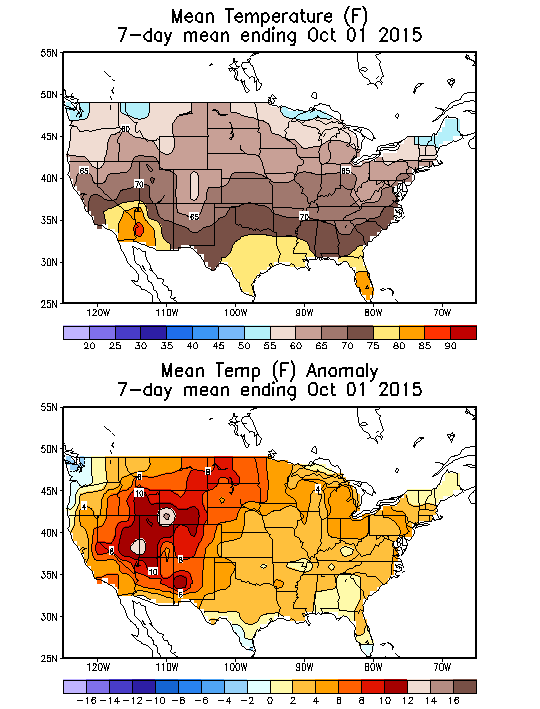
Source: NOAA/National Weather Service
Deviation between average and normal (°F)
7-Day Mean ending Oct 01, 2015

Source: NOAA/National Weather Service

